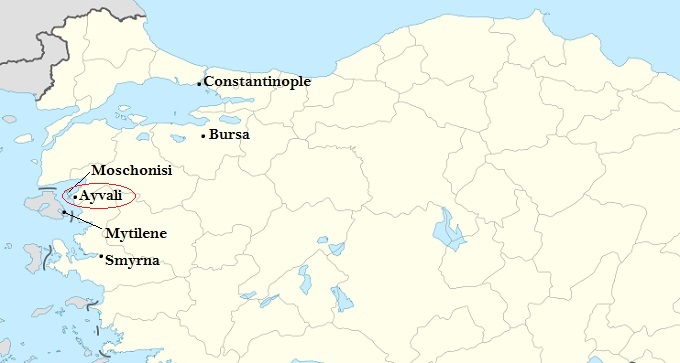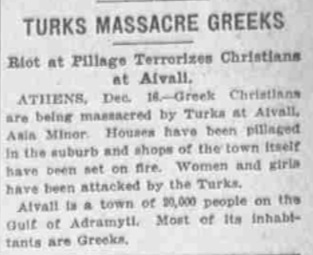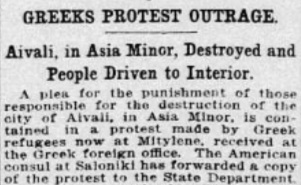
Map of current day Turkey.
The Greeks of Ayvalik (Gr: Aivali or Kydonies) and those from the neighboring Ayvalik Islands (Gr: Moschonisia) endured almost a decade of persecution during the Greek Genocide. Their persecution included massacre, deportation (death marches), boycotts, confiscation, and the destruction of their personal, cultural and religious property. The final demise of the Greek communities of Ayvalik came about in 1922 when those remaining were expelled to Greece and the Greek islands, while the Greeks of the Ayvalik Islands met a crueler fate.
Aivali
Ayvalik is situated on the western shoreline of Asia Minor (today Turkey) approximately 130km north of Smyrna (İzmir) and 25km east of the island of Lesvos. According to the Greek Patriarchate, the Diocese of Kydonies at the time comprised six communities and was inhabited by 26,387 people.1 Apart from 100 Turks, the town was almost exclusively made up of Orthodox Greeks. Ayvalik was one of the more prosperous communities of Asia Minor. It had its own college, three grammar schools for boys and three for girls as well as a higher institution for girls attended by 2,275 pupils. The town had 5,500 houses and 80 shops, 60,000 acres of olive tree farms, over 70 oil factories, 80 tanneries, 15 soap factories, 3 windmills and many quarries. It also had 11 churches, five town chapels and 72 rural chapels, four cemeteries, two monasteries and a hospital. Its harbor attracted large shipping activity with approximately 2,000 vessels entering each year.2
The Raids and Deportations (1914-1917)
The first phase of the persecution of the Greeks of Ayvalik and the Ayvalik Islands occurred in 1914 when their villages and towns were raided and pillaged. In May 1914, before the outbreak of WW1, Greek communities surrounding Ayvalik were attacked by armed Turks who stripped them of their valuables and clothes. As a result of these measures, thousands fled to neighboring Mytilene. According to a 1915 report by Dr Shwörbel, the second dragoman (interpreter) at the German Embassy, there was a pre-war population of 36,000 at Ayvalik, made up almost exclusively of Greeks and a third of them escaped to neighboring Mytilene after the first onslaught of 1914, leaving a population of only 22,000.3

The Evening Ledger, Philadelphia, 16 December 1914.
In the ensuing months, the attacks became widespread and eventually reached the town of Ayvalik itself. Farms belonging to Greeks were plundered and thousands of sheep stolen. Churches were ransacked and icons desecrated while young girls were taken away. According to news reports, the situation at Ayvalik was described as 'critical'. These initial attacks were conducted by bands of armed Turks who were recruited and led by civil and military officials.4 The report of an Englishman visiting one of the Aegean islands was published in the Manchester Guardian on the 29th of June 1914 and in it, the Englishman mentioned how all the villages in the environs of Ayvalik were being cleared of their inhabitants. He also stated that the kaymakam (governor) of Ayvalik told the inhabitants that they must go. The kaymakam said: "This is no longer your country; if you don't go today you will be compelled to go tomorrow."5
In addition to these measures, in July and August of 1914, Ottoman Greek males from Ayvalik between the ages of 18 and 48 were conscripted into the notorious Amele Taburlari (labor battalions) and were sent to the interior without adequate food and water provisions and made to work around the clock in horrendous conditions. Most perished due to ill-treatment, starvation, slaughter and disease. A German cablegram of the 12th of May 1918 to the Foreign Office in Berlin included statements by Ottoman prisoners who described the condition of these Greek draftees. One report mentioned how Greek millionaires from Ayvalik were deported to Mosul and Konya and were in rags begging, or occupied with roadwork.6
In July 1915, the media reported that the Greeks of Ayvalik had been ordered to evacuate the town in order to be driven to the interior.7 The report stirred public opinion and the Greek Government protested to the Sublime Porte (Ottoman Government). These deportations were supposedly executed on the grounds of military necessity. The extent of the deportations is unknown. While a general deportation was attempted on the 15th of September 1915, the 272 deportees were soon returned. Some Greeks were deported the following year. On the 13th of October 1916, The Liberal Democrat of Kansas reported that Turks arrested 500 notables and the Greek Metropolitan of Ayvalik and sent them all to the interior and subjected them to the roughest treatment.8
The deportation of Greeks from Ayvalik was renewed in 1917. In March of 1917 the town was occupied by three battalions of troops from Soma under the order of Vahid Bey, the Military Commander of the region. Before dawn on the day of their arrival, all males 15 years and upwards were arrested, while women and children were given five minutes to prepare for their deportation. The evacuation of the town was complete by the 30th of April, the population being scattered over the Bursa and Smyrna vilayets and the district of Karassi among inhospitable Turkish speaking villages. The town was then destroyed, the altars of its churches desecrated, its chapels demolished and shops plundered.9

The Greek Consulate at Ayvalik burnt by the Turks, 1922 (Aivaly le Consulat Hellenique incendie par les Turcs).
Source: Greek Literary and Historical Archive.
According to a Greek Legation report from Constantinople dated 24th of April and 1st of May 1917, Greek deportees from Ayvalik were in bad shape at Bursa (situated 290km from Ayvalik) and had been marching for 45 days en route to Yenisehir (60km from Bursa) and Bilecik (100km from Bursa). Due to fatigue and hardship they'd begged to stay in Bursa for at least a few days to rest but were denied. Over 180 died on the way, their bodies thrown into ditches while others half-dead were left on the side of the road, women after giving birth to babies abandoning them in order to continue the march. At the time of the report, 500-600 families had arrived and more were on their way, 200 families being settled at Tahtali and Yaylacik in the district of Bursa.10 A Greek soldier in the Ottoman Army testified that large numbers of families were encamped in a large plain an hour from Bursa and were dying from hunger, begging to be saved. According to the soldier, 25 Greeks from Ayvalik who he encountered, told him that their persecution began the week before Palm Sunday, continued during the Holy week and intensified on Good Friday. They were not allowed to take anything with them, and on the way gendarmes were demanding money from them. One-hundred and twenty had died in their group. They had been settled at Yaylacik and Tahtali, two hours from Bursa.11
Reports in the media during the latter part of 1917 indicated that the deportations were not only forced, but atrocities were committed on deportees. On the 15th of August 1917, the Evening Star of Washington reported that the American Consul at Salonica received a protest from Greeks of Ayvalik at Mytilene who were protesting about their treatment, calling for those responsible for the destruction of their town to be punished. The letter was forwarded to the US State Department and contained the following statement:
We denounce the horrible and unjustifiable destruction of the historic city of Aivali in Asia Minor, our fatherland. More than 30,000 people, all Greeks, and mostly women and children, living in Aivali and the neighboring village of Moschonisi, have been forcibly driven into the interior in conformity with the inhuman plan of the German-Turks [and] have suffered unimaginable atrocities and an unheard of number massacred.12
Between 1917-1921, Frank W. Jackson served as chairman of the Greek Relief Committee, a New York based organization formed to provide relief to Ottoman Greeks in response to the genocide. As chairman of the committee, Jackson made statements which were published in numerous newspapers at the time, describing the plight of the Ottoman Greeks. On the 17th of October 1917, the Evening Independent published a news piece in which Jackson highlighted the excessive measures taken against Greeks and mentioned the massacre of thousands of Greek deportees. Jackson stated:
Along with the [Armenians] most of the Greeks of the Marmora regions and Thrace have been deported on the pretext that they gave information to the enemy. Along the Aegean Coast Ayvalik stands out as the worst sufferer. According to one report some 70,000 Greeks there have been deported toward [Konya] and beyond. At least 7,000 have been slaughtered. The Greek Bishop of Ayvalik committed suicide in despair.13

The Evening Star, Washington, 15 August 1917.
The deportation of Greeks from Ayvalik was carried out by the Young Turks under the order of German General Liman von Sanders who was head of the Military Reorganization Commission and later Commander of the 5th Army Corps of the Ottoman Empire. Only half of the Greeks deported by von Sanders returned to their homes in late 1918 following the Ottoman Empire's defeat in WW1. Sanders was arrested by British forces when he attempted to return to Germany in February 1919 and was held at Malta for six months as a war criminal. A 1919 news report stated:
Sanders is first of the German commanders to be seized for trial for violation of the rules of warfare. And he’s going to be tried in Constantinople too. Sanders was in command of the Turkish forces which were operating under direction of Berlin. He is known to have sanctioned Turkish atrocities, including massacres of Greeks and Armenians.14
It's worth noting that not all German officials agreed with the deportations taking place in the Ottoman Empire at the time. In 1916, Count Paul Wolff-Metternich, the German Ambassador in Turkey was recalled by the Kaiser on the demands of Enver Pasha and the German military authorities in Constantinople. Wolff-Metternich attempted to intervene with the deportation of Greeks and Armenians but his superior considered him to be favoring the Christians and in so doing "wounding the amour proper of the Turks."15
The Final Expulsion: 1922
The final expulsion of the Greeks from Ayvalik came about following the burning of Smyrna in September 1922. While initial relief efforts to save the remaining Christian population centered on Smyrna, efforts soon turned to places where other Greeks were awaiting rescue. On the 28th of September 1922, US Lieutenant Commander Halsey Powell sent a US warship to Ayvalik as part of a relief effort to save Christians believed to be stranded there. Upon arrival, Turkish authorities advised US personnel that there were no people to evacuate and that the Greeks wanted to stay.16 Powell was later informed that the Greeks were fearful of requesting evacuation. On the 2nd of October 1922 the Macleish escorted Greek merchant ships to Ayvalik where 10,000 refugees were waiting. On arrival, Turkish machine guns fired on a US whaleboat and shot down its flag. The Turkish gunner denied there were refugees in the town, however the American officer insisted on seeing senior Turkish officers and eventually the American crew was allowed to embark the refugees who had been gathered out of sight of the waterfront.17
The majority of those able to be rescued aboard the ships were women and children. Turkish authorities refused males between the ages of 18-45 from boarding and instead sent them to the interior where they were enslaved in labor battalions. One of the Greeks from Aivali who was sent to the interior during this period was Elias Venezis. Venezis was born at Ayvalik in 1904 and was 18 years of age when he was arrested and taken prisoner. Of the 3,000 Greek men conscripted into Venezis' battalion, only 23 survived. One of them was Venezis. His memoir, published under the title To Noumero 31328: To Vivlio tis Sklavis (The Number 31328: The Book of Slavery), with 31328 being the number he was assigned as a prisoner, describes long marches without food and water, gang rapes and mass killings. In Chapter 18, Venezis describes how he and a group of prisoners are asked to hide the bodies of massacred Christians before the arrival of a Commission from the League of Nations. Venezis recounted:
One morning they took about 60 prisoners out to do a job at a place just outside of Magnesia (today Manisa). Opposite the railroad tracks near Sipilos, is the end point of a large ravine. They call it Kirtik-Dere. Inside this ravine it was estimated that they'd killed about 40,000 Christians from Smyrna (İzmir) and Magnesia during the early days of the Smyrna Holocaust; males and females. The bodies had melted over winter, and the water of the gorge which descended from above, pushed the corpses further down. Our job all day was to push the corpses back in, so that they couldn't be seen.18
The Ayvalik Islands (Gr: Moschonisia)
The Ayvalik Islands were a group of twenty-two islands situated just off the coast of Ayvalik. The largest of the islands was called Moschonisi (Tr: Cunda Adasi or Alibey Adasi) and the town of the island was also called Moschonisi. The entire population throughout the Ayvalik Islands was 9,000 while the island of Moschonisi had a population of 6,000, all Greeks.19 The town of Moschonisi comprised five churches and an equal number of monasteries, while in total there were fifty churches throughout the islands. The persecution of the Greeks of the Ayvalik Islands followed a similar course to that of the Greeks of Ayvalik. It began in May 1914 with boycotts and violence and was followed by deportations to the interior of Asia Minor. A report of 12 December 1914 describes how churches were looted and men and women tortured and beaten while the Bishop Photios, various priests and prominent men were imprisoned in a mill for days. There were also searches to find men who had deserted from their conscription into Ottoman labor battalions. During these searches crowds of bashibazouks surrounded the town awaiting the signal to enter and loot and destroy. The Military Governor was heard saying: "One or two more such searches and the city will be emptied of its men. Then we will kick the women into the sea." 20

The church of St.Trinity on Moschonisi desecrated by the Turks, its sacred objects broken and thrown out of the church.
Source: Hellenic Literary and Historical Archive.
The Greeks of Moschonisi were deported to Ayvalik and then scattered among Turkish villages in the vilayets of Bursa and Smyrna. Many died during these deportations. After they were deported, their churches were turned into warehouses and stables, their religious ornaments and artwork desecrated and destroyed and their houses made uninhabitable. The last phase of the persecution of the Greeks of Moschonisi came in September 1922 when the remaining Greeks of Moschonisi were slaughtered en masse. Panayiotis Bibela survived deportation to the interior of Turkey in 1922 because he was secretary of the tax department for the schools of Ayvali. Regarding the fate of the Greeks of Moschonisi, Bibela recounted:
It is fact that from the town of Moschonisi nobody managed to escape because the entire population, male and female was executed with shotguns a few kilometers outside of the town one night.21
Aristidis Hiotopoulos was spared the ignominy of the slave battalions at Ayvali because he had ties with a French family. When describing the events at Moschonisi Hiotopoulos stated:
The population of Moschonisi was taken to the interior and massacred. Only 2 or 3 girls survived and we learned from them years later what happened.22
1. Greek Patriarchate, Persecution of the Greeks in Turkey 1914-1918, Constantinople, 1919, 64.
2. American Hellenic Society, Persecution of the Greeks in Turkey Since the Beginning of the European War, Oxford University Press, 1918, 56-57.
3. Hofmann T, The Genocide of the Ottoman Greeks, Caratzas, New York, 2011, 54.
4. American Hellenic Society, ibid, 66.
5. Hofmann T, ibid 53.
6. ibid, 64.
7. A Crisis at Aivali. The Scotsman, 20 July 1915.
8. The Democrat, Liberal Kansas, 13 Oct 1916.,
9. Greek Patriarchate, ibid, 67.
10. American Hellenic Society, ibid, 57.
11. ibid, 58.
12. Greeks Protest Outrage, Aivali in Asia Minor Destroyed and People Driven to Interior, The Evening Star, Washington, 15 Aug 1917.
13. Turks Turned Against Greek, The Evening Independent 17 Oct 1917.
14. First Hun Held For Atrocities, The Evening Independent, 15 Mar 1919.
15. Turks Harry Greeks, Awful Stories Told. Tortures Inflicted. Daily Herald, South Australia, 11 Apr 1918.
16. Ureneck L, The Great Fire, One Man's Mission to Rescue Victims of the 20th Century's First Genocide, Harper Collins, 2015, 380.
17. ibid, 384.
18. Venezis E, To Noumero 31328, Chapter 18. Athens 2004, 165.
19. Greek Patriarchate, ibid, 69.
20. American Hellenic Society, ibid, 11-12.
21. The Exodus, Volume A, Center of Asia Minor Studies, Athens, 1980, 100.
22. ibid, 96.
Related:
Testimony of the town crier of Ayvalik



